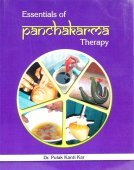Kalpasthana, Kalpasthāna, Kalpa-sthana: 6 definitions
Introduction:
Kalpasthana means something in Hinduism, Sanskrit. If you want to know the exact meaning, history, etymology or English translation of this term then check out the descriptions on this page. Add your comment or reference to a book if you want to contribute to this summary article.
In Hinduism
Ayurveda (science of life)
Dietetics and Culinary Art (such as household cooking)
Source: Shodhganga: Dietetics and culinary art in ancient and medieval India1) Kalpasthāna (कल्पस्थान) refers to the seventh of the eight sections of the Carakasaṃhitā which enjoys a prime position among Ayurvedic treatises and is written in the form of advices of the sage Ātreya to the sage Agniveśa. The Carakasaṃhitā contains eight sections [viz., kalpasthāna]. Sūtrasthāna contains 30 chapters.
2) Kalpasthāna (कल्पस्थान) refers to one of the six sections of the Suśrutasaṃhitā, an important Ayurvedic treatise. The discourses of the teacher Divodasa are believed to be summarised by his disciple Suśruta, who wrote the work Suśrutasaṃhitā in 4th century CE. Suśrutasaṃhitā contains six sections [viz., kalpasthāna].
3) Kalpasthāna (कल्पस्थान) also refers to one of the six sections of the 5th century Aṣṭāṅgahṛdaya by Vāgbhaṭa. Aṣṭāṅgahṛdaya is divided into two—pūrvatantra and uttaratantra. In the pūrvatantra there are five divisions which go by the names sūtrasthāna, nidānasthāna, śarīrasthāna, cikitsāsthāna and kalpasthāna.
Unclassified Ayurveda definitions
Source: Wisdom Library: Āyurveda and botanyKalpasthāna (कल्पस्थान).—Fourth book of the Purva-tantra (part of the Sushruta Samhita, an ayurvedic text). It deals with the nature of poisons and their management.

Āyurveda (आयुर्वेद, ayurveda) is a branch of Indian science dealing with medicine, herbalism, taxology, anatomy, surgery, alchemy and related topics. Traditional practice of Āyurveda in ancient India dates back to at least the first millenium BC. Literature is commonly written in Sanskrit using various poetic metres.
Languages of India and abroad
Sanskrit dictionary
Source: DDSA: The practical Sanskrit-English dictionaryKalpasthāna (कल्पस्थान).—
1) the art of preparing drugs; Charak 7.
2) the science of poisons and antidotes; Suśr.
Derivable forms: kalpasthānam (कल्पस्थानम्).
Kalpasthāna is a Sanskrit compound consisting of the terms kalpa and sthāna (स्थान).
Source: Cologne Digital Sanskrit Dictionaries: Monier-Williams Sanskrit-English Dictionary1) Kalpasthāna (कल्पस्थान):—[=kalpa-sthāna] [from kalpa] n. the art of preparing drugs, [Caraka vii]
2) [v.s. ...] the science of poisons and antidotes, [Suśruta]
[Sanskrit to German]
Sanskrit, also spelled संस्कृतम् (saṃskṛtam), is an ancient language of India commonly seen as the grandmother of the Indo-European language family (even English!). Closely allied with Prakrit and Pali, Sanskrit is more exhaustive in both grammar and terms and has the most extensive collection of literature in the world, greatly surpassing its sister-languages Greek and Latin.
See also (Relevant definitions)
Partial matches: Sthana, Kalpa.
Full-text (+2): Samjivana, Sushruta-samhita, Mandalin, Visha, Ashtangahridaya, Kala, Caraka-samhita, Agadatantra, Vishatantra, Shadava, Nirantarapadavyakhya, Raga, Vishacikitsa, Cikitsasthana, Nidanasthana, Sharirasthana, Vikalpa, Parushaka, Sutrasthana, Upanishad.
Relevant text
Search found 12 books and stories containing Kalpasthana, Kalpasthāna, Kalpa-sthana, Kalpa-sthāna; (plurals include: Kalpasthanas, Kalpasthānas, sthanas, sthānas). You can also click to the full overview containing English textual excerpts. Below are direct links for the most relevant articles:
Charaka Samhita (English translation) (by Shree Gulabkunverba Ayurvedic Society)
Kalpasthana (Kalpa Sthana) — Section on Pharmaceutics
Chapter 1a - Introduction to the Kalpasthana < [Kalpasthana (Kalpa Sthana) — Section on Pharmaceutics]
Charaka Samhita and Sushruta Samhita (by Nayana Sharma)
The Royal Physician < [Chapter 2]
The Saṃhitās (Introduction) < [Chapter 1]
Class and Gender (Introduction) < [Chapter 5]
History of Indian Medicine (and Ayurveda) (by Shree Gulabkunverba Ayurvedic Society)
Chapter 22 - Pharmacy < [Part 2-3 - Medical Institutions in Ancient India]
Chapter 8 - Treatment and the Status of the Patient < [Part 4 - Some Aspects of Life in Caraka’s Times]
Chapter 14 - Legends and Mantras < [Part 4 - Some Aspects of Life in Caraka’s Times]
Atharvaveda and Charaka Samhita (by Laxmi Maji)
Bhela and Bhela Saṃhitā < [Chapter 1 - Introduction]
Agniveśa (Āyurveda scholars) < [Chapter 1 - Introduction]
Aṣṭāṅga-Saṃgraha (Āyurveda book) < [Chapter 1 - Introduction]
Sushruta Samhita, Volume 5: Kalpasthana (by Kaviraj Kunja Lal Bhishagratna)
Chapter III - Description of Jangama (animal) poisons
Philosophy of Charaka-samhita (by Asokan. G)
Related products
